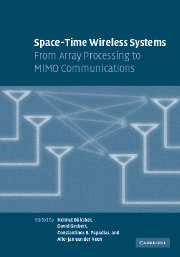Book contents
- Frontmatter
- Contents
- List of contributors
- Acknowledgments
- Introduction
- Part I Multiantenna basics
- 1 Propagation aspects of MIMO channel modeling
- 2 Beamforming techniques
- 3 Diversity in wireless systems
- 4 Fundamentals of MIMO channel capacity
- 5 Multiantenna capacity: myths and realities
- 6 The role of feedback, CSI, and coherence in MIMO systems
- Part II Space-time modulation and coding
- Part III Receiver algorithms and parameter estimation
- Part IV System-level issues of multiantenna systems
- Part V Implementations, measurements, prototypes, and standards
- Index
1 - Propagation aspects of MIMO channel modeling
Published online by Cambridge University Press: 25 February 2010
- Frontmatter
- Contents
- List of contributors
- Acknowledgments
- Introduction
- Part I Multiantenna basics
- 1 Propagation aspects of MIMO channel modeling
- 2 Beamforming techniques
- 3 Diversity in wireless systems
- 4 Fundamentals of MIMO channel capacity
- 5 Multiantenna capacity: myths and realities
- 6 The role of feedback, CSI, and coherence in MIMO systems
- Part II Space-time modulation and coding
- Part III Receiver algorithms and parameter estimation
- Part IV System-level issues of multiantenna systems
- Part V Implementations, measurements, prototypes, and standards
- Index
Summary
Introduction
The MIMO link consists of two antennas, one at each end of a link, where each antenna consists of several elements, which can be treated independently. In addition, the environment should allow several paths to exist from each antenna element at one end to each element at the other end. If these paths are “different” in a way to be explained, the simple two-antenna case turns into a multichannel case with high order of diversity and the possibility of enhanced spectral efficiency due to the parallel nature of the channels. We thus have a matrix channel in contrast to the usual scalar channel. The environment may also be modeled, but we shall restrict the analysis to rather simple scattering situations, which hopefully will have enough generality to cover most real cases. To define the words used, a path (or ray) is defined as a transmission between an antenna element and a scatterer or between two scatterers, while by transmission coefficient we mean the sum of paths connecting an element on one side to an element on the other side.
The modeling of MIMO channels is a multistep procedure. If realistic modeling is wanted, it must be based on measurements from which the relevant features are extracted. Significant determinants are the correlations between the transmission coefficients and the number of scatterers. Assuming more general randomness, a simulation model may be required to satisfy the experimental conditions only approximately in order to simplify matters.
- Type
- Chapter
- Information
- Space-Time Wireless SystemsFrom Array Processing to MIMO Communications, pp. 3 - 22Publisher: Cambridge University PressPrint publication year: 2006
- 3
- Cited by



